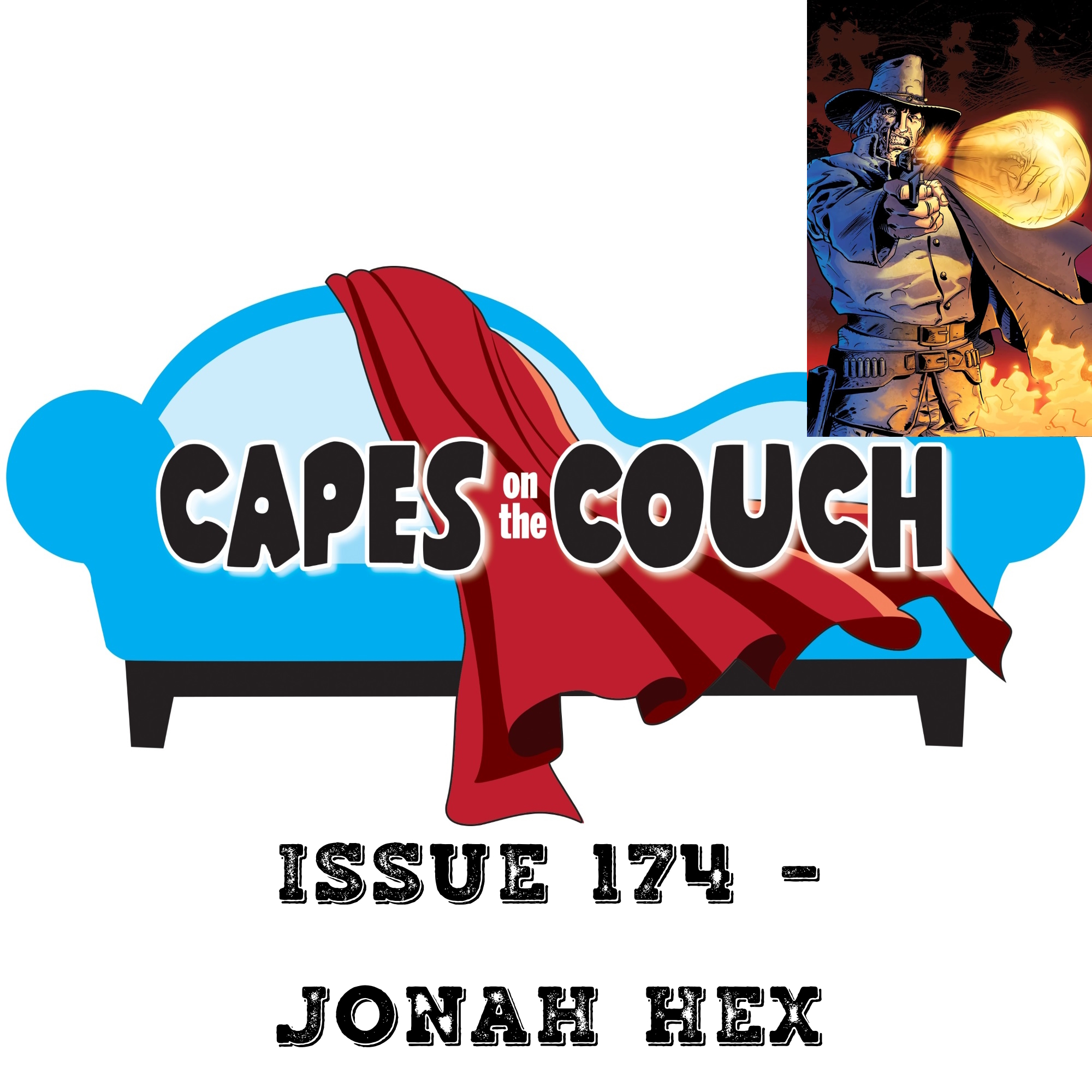Singular Visions 1.1
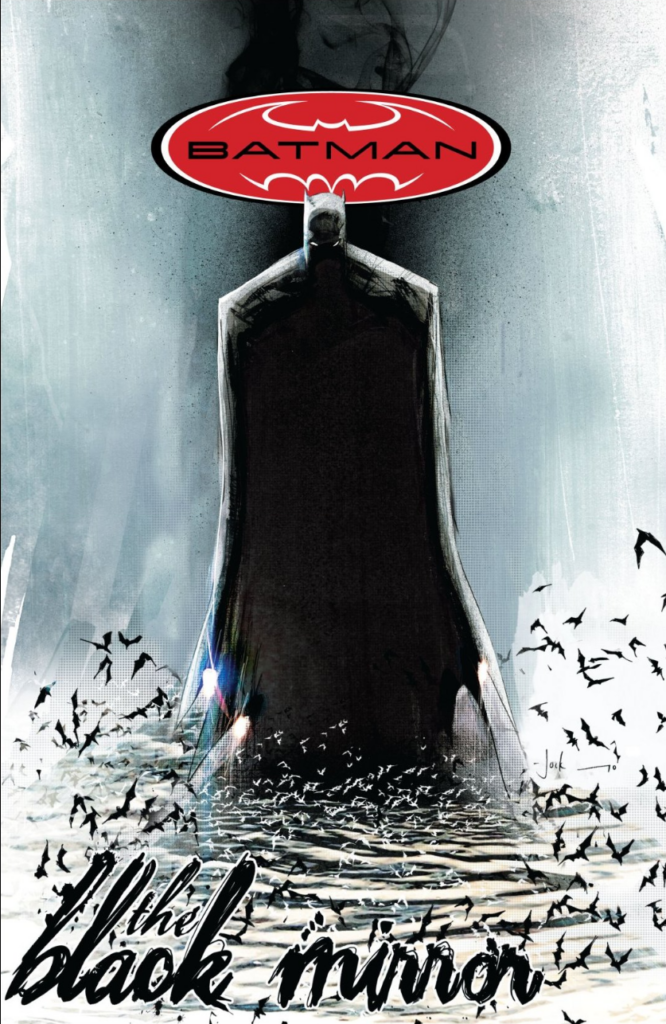
Batman: The Black Mirror
Writer: Scott Snyder
Artist: Jock, Francesco Francavilla
Color Artist: David Baron, Francesco Francavilla
Letterer: Jared K Fletcher
Publisher: DC Comics
Spoiler Level: RED
The Singular Vision that is Scott Snyder’s DC Work
When Scott Snyder first started setting the sales charts ablaze with his Batman run, I was mid- break from comics. As a result, I only really started reading him during his Justice League run. Talk about being a late bloomer as a reader.
Nevertheless I was aware of him – how could I not be? For over a decade, Snyder was perhaps the most influential non-editorial architect of the DC Universe. After Dan Didio’s departure, he became even more influential as his then upcoming event series “Death Metal” became the mechanism by which DC ultimately (finally, in theory) settled its fractured continuity. That’s a hard act to follow even for Snyder, and he soon chose to step back for a while and focus on creator owned properties.
Unsurprisingly, his decision sparked myriad conversations; for me, the most interesting was the question of his “authorial thread” so to speak. I have no idea what else to call it so if that makes no sense… let me explain.
Long comic narratives interest me, particularly those driven by a single person’s unifying vision. This could be a single title thread – Marv Wolfman on Titans, for example – or a corner-of-the-publishing-line thread – Chris Claremont on every X-Men related title at once, for example. But those are only the most obvious ones – there are a great many more author-specific mini-threads winding through a company’s body of work, following a creator as they move from book to book developing their favorite characters, relationships and plot points along the way. The latter is, I suspect, the most common kind of thread.
What’s less common is an author-specific mini-thread that grows to encompass the entire universe in which it originally resided. So when I heard that Snyder’s work foreshadows, self-references, and develops throughlines that encompass his entire DC comics body or work – the body of work that eventually culminated in Perpetua, the Batman who Laughed and ultimately Death Metal? Well, color me intrigued.
That leads me here, to the first installment of Singular Visions: Scott Snyder, in which I will be reading his entire body of DC work and talking about it as I go. This is not going to be a straight through, every column until it’s done project – if it were, I’d be writing column after column about Snyder for the next I have-no-idea. Instead, consider it a long-term, recurring project.
As a late bloomer, it’s worth noting that there’s a lot of his work that I’ve never read, so it should be an interesting ride for everyone involved.
This being Batman month at Capes on the Couch, it seems fitting to begin this multi-part journey with a look at Snyder’s first published Batman work, Black Mirror.
An Introduction to Black Mirror
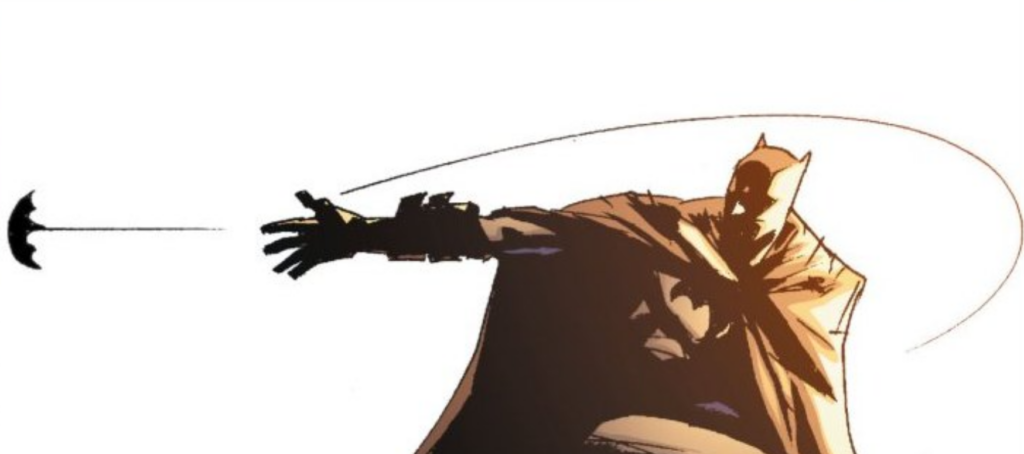
Originally published in Detective Comics #876-881, Black Mirror stars a Batman but not the Batman.
For context, when Snyder began his Batman career on Detective Comics (with the phenomenal Jock, David Baron and Jared K. Fletcher), Bruce Wayne was believed dead – killed by Darkseid during the Final Crisis. During Bruce’s absence his original protégé, Dick Grayson, put his own vigilante identity on the back shelf and stepped into Bruce’s suit as the new Batman. Eventually, Bruce returned, as he always does, but opted to leave Gotham in Dick’s hands; Bruce, meanwhile, went on the road setting up his international crimefighting project, Batman Incorporated. Dick moved into Bruce’s old Penthouse and got to city-protecting.
So, long story short, Black Mirror’s Batman is Dick Grayson… and the story is of course differently structured, its villains differently built, to accommodate the difference in personality between Dick and Bruce.
1. Black Mirror
For about two issues of Snyder’s Detective run, issues were split between a lead Dick Grayson feature and a backup starring Commissioner Gordon. They also vaguely reference one another, so we can assume they happen roughly simultaneously. You could even say they… mirror—I’m sorry, let me show a little more self-respect.
But, okay. It shouldn’t surprise anyone that mirroring is indeed a significant theme in Black Mirror, both arc and collection. Our first antagonist is “The Mirror House,” an operation run by The Dealer, a man of unknown origin going by the probable alias, “Etienne Guiborg.” The House’s existence comes to light when a vial of the mutagen that once transformed Waylon Jones into his most reptile-adjacent form turns up in the locker of a 12-year-old boy named Dana Redford.
But let’s backtrack for a moment.
We first meet Dana Redford as a normal kid who is the target of the kind of dime a dozen school bullies that so many of us knew as children. It’s not fine, it’s not okay, but it’s not unusual… until Dana reaches his limit. Determined, he pursues his tormentor, shoving both himself and the bully into the nearby swimming pool. Moments later, prey becomes predator as Dana emerges from the water covered in scales with monstrous, bloody teeth, surrounded by the castoff splatter produced when he bites off the bully’s hand. A baby Killer Croc – one of Gotham’s special breed of monsters reflected back in the city’s eye.
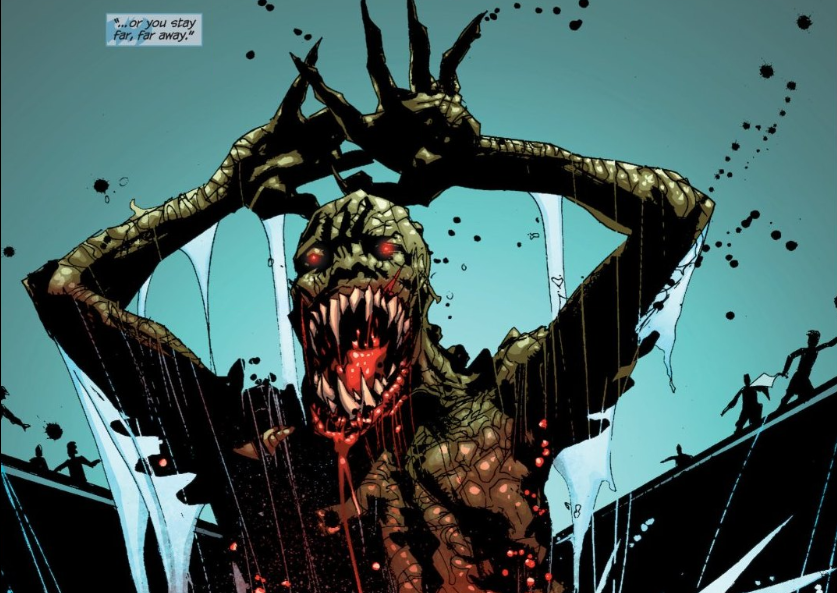
Dana’s drama plays out as the backdrop to Dick’s opening commentary – a reminiscence back to his childhood, when he was the third in a trio of Flying Graysons. At the time, his father had the United States map plotted out with colored pins to indicate what kind of show would be needed to thrill the location – blue for small towns and easy shows, red for big cities and difficult shows. Then there was Gotham – black pin. No holds barred, no safety nets – give Gotham everything you’ve got, because the city is hungry and if you don’t feed it, it will feed on you. And then, embodying the city’s appetite, we fade into Dick staring out the window at a pair of vultures.
We’ll soon learn that the birds have been freed as part of James Gordon Jr.’s return to Gotham. But for now they are just… there. Odd, and out of place, waiting for dead meat.

Scavengers, unbelonging – these themes are raised several times over the course of the collection, starting here and progressing to the villain of the first arc, Guiborg’s Mirror House.
The Mirror House is, in some ways, a conceptual test run for the Court of Owls – both consisting of elite families and individuals who are actively involved in or fascinated by the darkness at Gotham’s heart. Members of the Mirror House believe that it the capacity for evil that sets mankind apart from other animals, and as such they celebrate malevolence as divine.
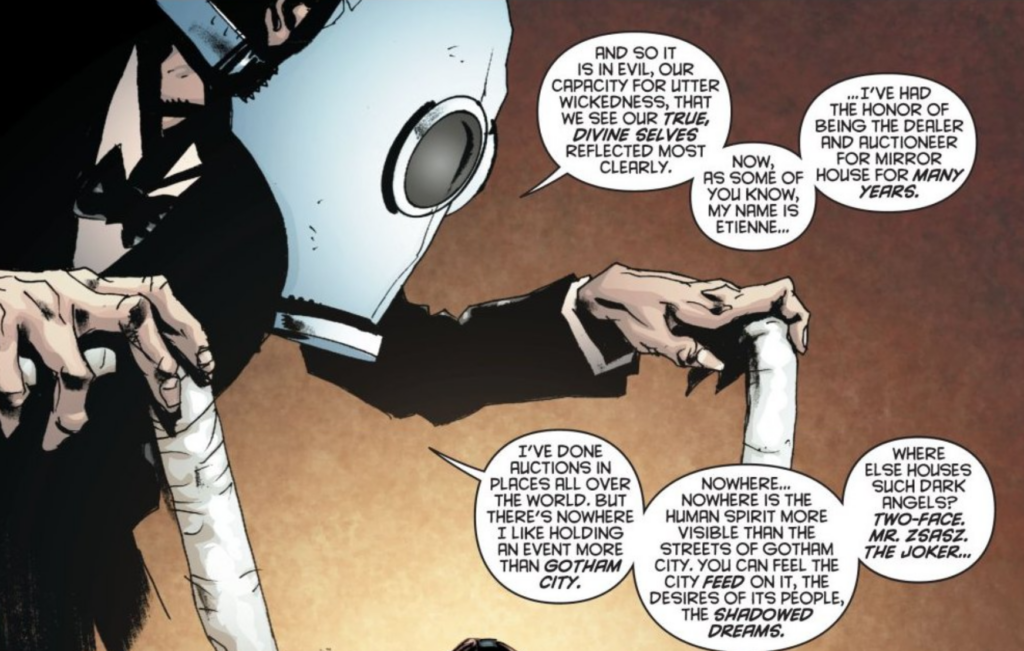
They are also vultures – a fact made visually evident through Guiburg’s hunched stance and the vaguely beakish downward turn of the gas masks worn by every member. They are garbage picking scavengers, hovering over atrocities ready to pick the (real or metaphorical) corpses of the world clean for souvenirs – including the mutagen used by Redford – which they then sell at auction.
Dick sets about hunting them down and, after witnessing a murder-suicide linked to an old form of Mad Hatter’s mind-control cards and the death of a former cop via spontaneous vine growth, he arrives at the current auction site: Harbor House, an abandoned event hall that never recovered after a mass death event during the earthquake of No Man’s Land. He infiltrates the group long enough to see The Dealer attempt to auction off the crowbar used to murder Jason Todd. Subsequently exposed by Guiborg as Batman, Dick is forced to flee, though not before being dosed with a powerful hallucinogenic poison. Dick will struggle with this toxin’s ability to break down the barriers between nightmares and reality for the remainder of the volume.
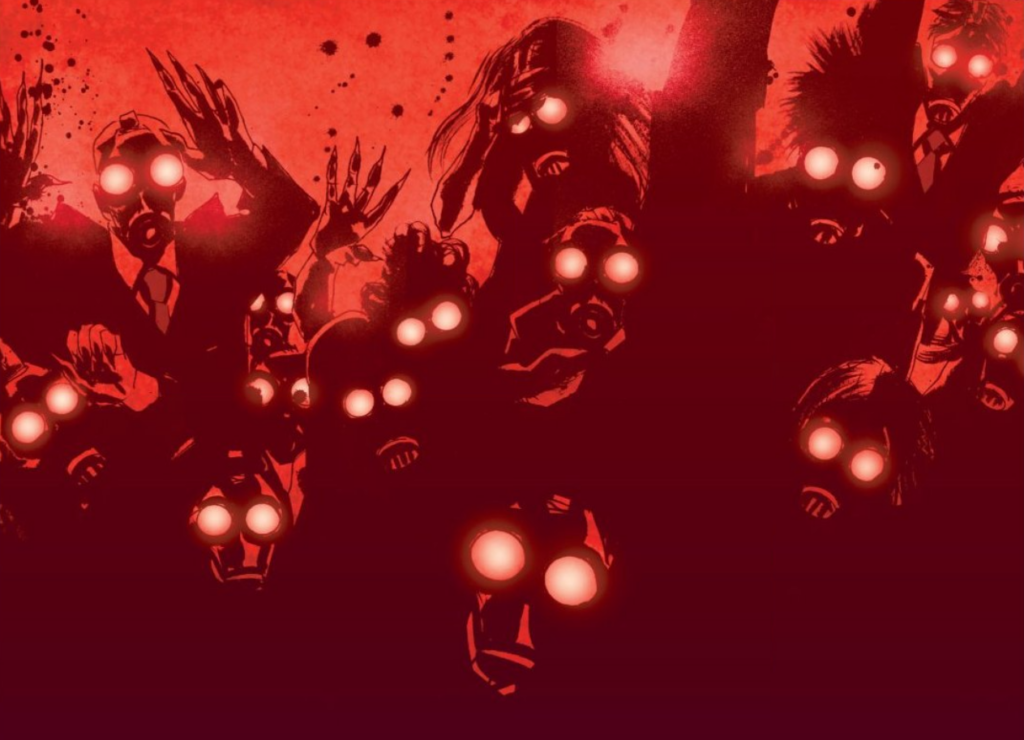
First up in the nightmare lineup: the unending need that is duty, love, city, as demonstrated by Dick’s all too real nightmare of waking up, his legs having been devoured by the Mirror House patrons, only to have Barbara Gordon declare her love for him as she tries to cut off a piece as well. Only a few pages later, this twisted, destructive vision of love will resurface as Dick corners Guiborg only to have him declare his love for Batman, and his devotion to the “magnificent infection” Batman has spread to Gotham; he does this while transforming into an amalgam of Man-Bat and Bane via a dose of an old version of Langstrom’s serum mixed with Venom.
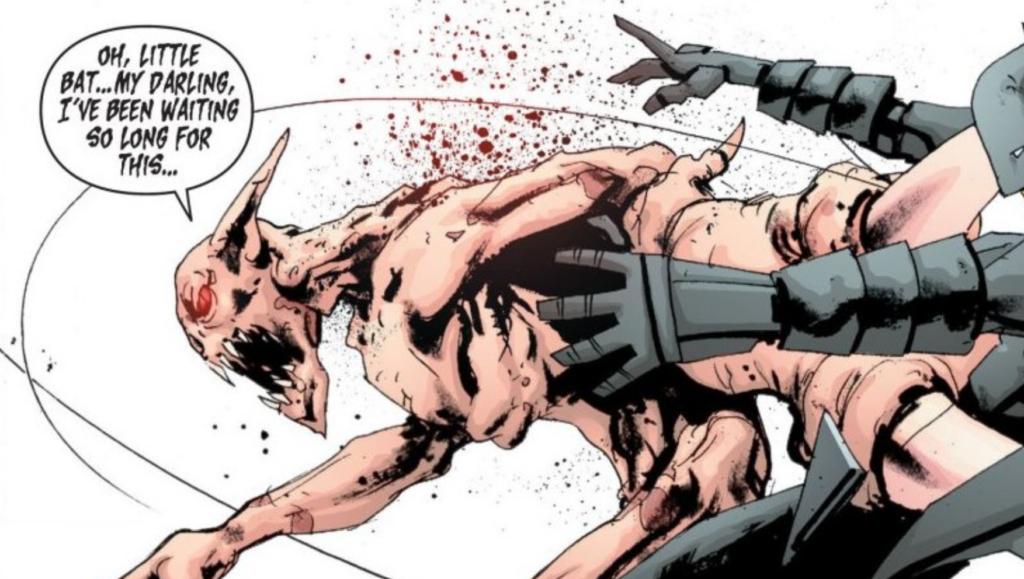
Now I’m going to go down a road, and I promise I’ll get back on track, you just have to follow me for a moment. Here we go:
Dick Grayson doesn’t want to be Batman. Most of us know that, but it bears repeating now, as I go through this volume of horror-flavored stories anchored on Dick Grayson as Batman, because if we want to really get the foundations down for this volume, it’s important to orient ourselves. At the time of Black Mirror, Dick was operating as the Batman of Gotham City, and living in Bruce’s old penthouse. Alfred, too, had settled there as Bruce was off gallivanting around the world.

So, let’s go back to Dick watching the misplaced vultures; in this scene, Dick is also having a conversation with Alfred about how unlived in and impersonal the penthouse looks. Dick had done nothing to make the place “his own,” in essence – and why would he? He doesn’t say it, but he’s struggling with his role as Batman – especially with Bruce back in the world (he does say that part, in fact).

Being Batman is a burden to him – a duty, rather than a labor of love. It’s evident on his face: how tired he looks, how joyless he is. But more than that, it’s reflected in these stories – the way Gotham’s darkness is embodied in the vulture-like Mirror society trying to devour him alive. It’s reflected, too, in the visions that haunt him once he’s been dosed by the toxin – the destructive, obsessive love directed at him by his vision of Barbara, and by Guiborg in general. What’s more, it’s worth noting that Guiborg’s “love” (assuming Dick isn’t hallucinating the dialogue) is actually directed at Bruce, Guiborg just doesn’t realize he isn’t speaking to the original Batman. In essence, Dick is a son living in the shadow of his father, trying to conform to his father’s mold, despite their being very different people with very different priorities, different desires. If you’ve read Black Mirror you can predict where this is going by the end of today’s column.
But back to Dick. He loves Bruce, and he loves Gotham, so he’s trying. At the end of Black Mirror (the arc), he begins to set up the penthouse for long-term residence – his police certificate, a poster of his parents, and, of course, a mirror.
A mirror in which he sees himself, framed by the city that is his home, and his cage.
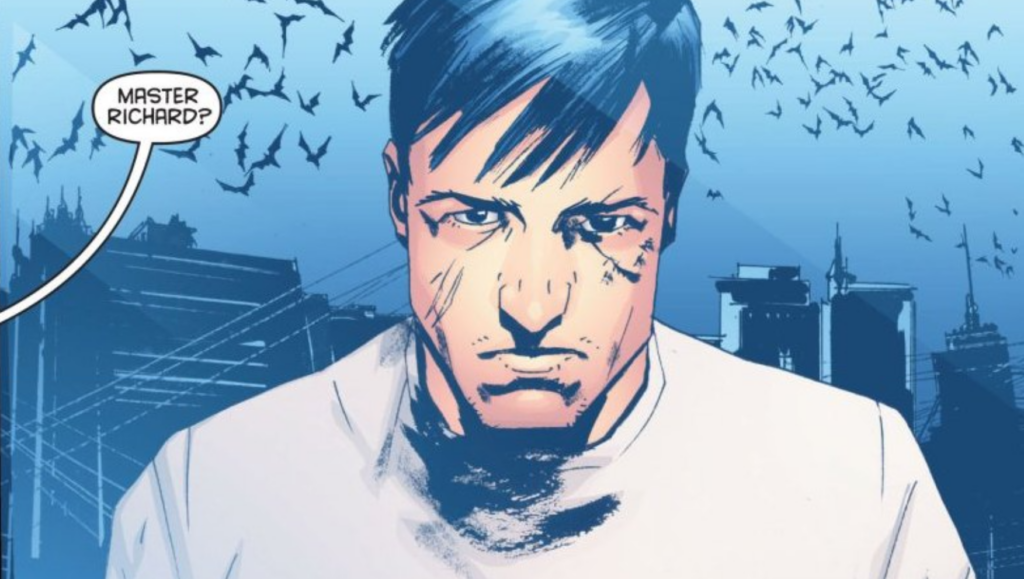
2. Skeleton Cases
There’s a reason I mentioned that Skeleton Cases originated as a backup behind Dick’s adventures. Not only do they reference one another (more on that in a moment), they are also reflections of one another. Where the Black Mirror arc is the story of a son living with the shadow of his absent father, Skeleton Cases is the story of a father dealing with the shadow of his prodigal son.
Here, I am talking about James Gordon Jr, who makes his non-infant debut here. He returns, after many years of estrangement, amidst a bit of chaos. The Gotham Aviary’s exotic bird collection has been breached, the cages opened and the birds freed – thus the vultures lingering outside Dick’s window. And while the specifics of James’ exile – the way and when of it – take some time to unravel, it doesn’t take long to get the edges and shape of it. From the moment Harvey Bullock shows Commissioner Gordon the CCTV footage of the Gotham Aviary we know that there is something troubling about James – it’s evident in the tension between James’ mild face and the sudden fear on Jim’s.

Here is Jim Gordon, decorated veteran officer – a man who has stared down the Joker – struck dumb with horror at the sight of his own son.
That horror lingers, resurfaces when Jim finds his apartment floor streaked with blood. When stepping into such a scene, what does it say that Jim’s first thought is to call for his son? It isn’t James, in the end – only what seems to be a golden eagle or other large predatory bird carrying its kill in one talon, trailing blood in its wake. As completely as Dick finding a small flock of vultures outside his window heralded the coming of The Dealer, so does this bird announce the arrival of James Golden Jr. who is, after all, less a scavenger than a predator.
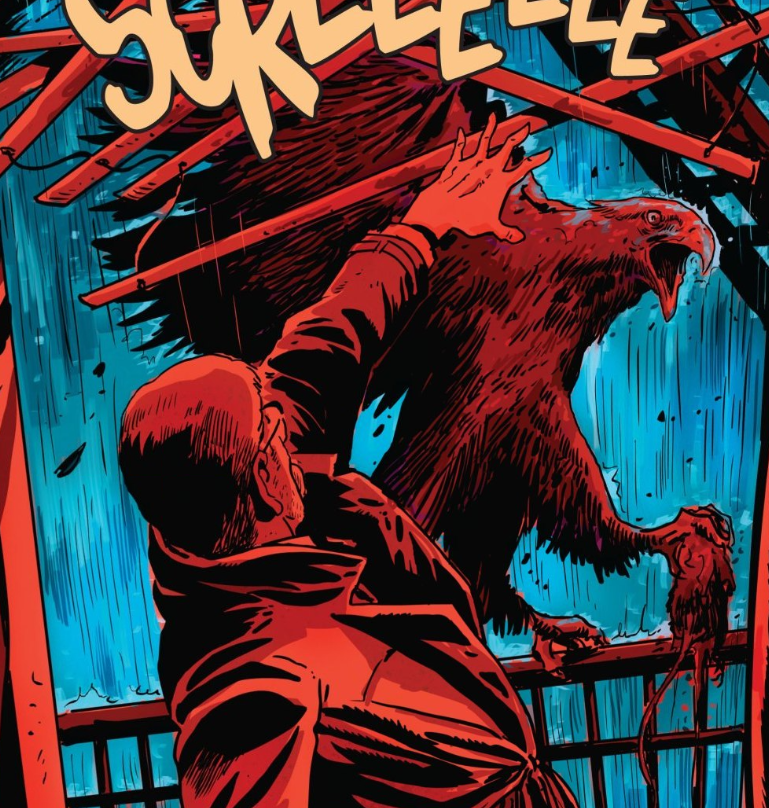
Following parental protocol, Gordon Senior meets with Barbara in a diner. This is one of Barbara’s later appearances during the Oracle era, which is pretty notable: Barbara here is older, wiser and tougher than she will later be portrayed. It’s through her strength, and Jim’s – as well as the conversation between Jim and James Jr. that follows – that we first see James Gordon Jr. He is, in short, a plain faced, mild looking young man whose bone-chilling presence activates the fight or flight mechanism in even his own family, leaving Barbara Gordon of all people suffering from nightmares.
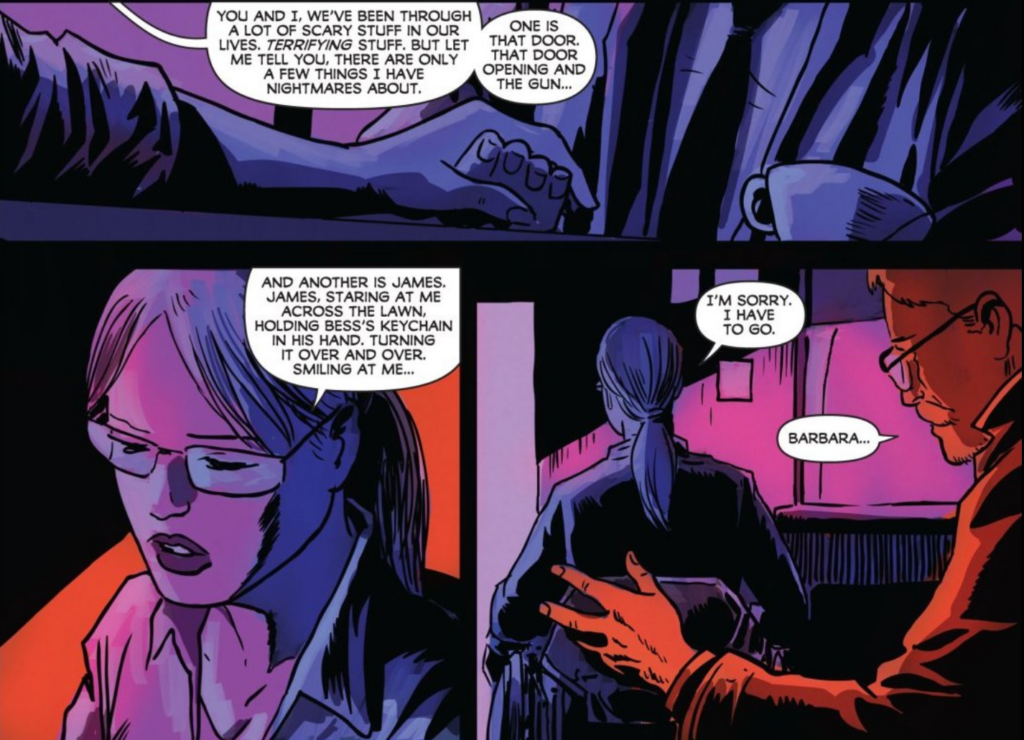
Also, isn’t it interesting that his first act upon arrival in Gotham is to open the cage of some of the most predatory or corpse devouring animals in the city?
It’s after the second issue of Skeleton Cases that the format of Detective Comics shifted, eliminating the lead/backup in favor of a longer full issue story. There are a few side effects to this, one of which is that Francesco Francavilla, the artist and colorist for the backups, begins to rotate duties with Jock and David Baron, the team for the leads.
Both teams produce phenomenal work but I can’t stress enough how perfect Francavilla is for the meeting between Gordons – his drawings and colors together create an uncomfortable tension, an eerie atmosphere, even in this simple diner scene. We see how strongly Jim and James Jr. resemble one another – their hair parts mirroring one another just as they have the same eyes, the same noses, even similar glasses. We see, as well, how different they are – Jr’s face goes expressionless, closes up and bars its windows, even as Jim’s opens, becomes more desperate, more hopeful. Jim’s eyes are expressive and alive, where James Jr’s never waver, never move, never change.

In short, James is “off.” Caught with what appears to be blood on his shirt, he opens their meeting with a joke about killing the waitress and stuffing her head in the toilet of the men’s room before admitting the red stain is just ketchup. How could he know what would be funny and what wouldn’t – after all, he is a psychopath. Still, James Jr. offers an olive branch – a promise that he is in drug therapy, and that it works. He’s home, and he wants to change, and fit into society, and into his family. He says this as, behind him, as the men’s room begins to flood, water beginning to trickle under the door into the main diner, leaving Jim to juggle his hopes for his son with his fear of his son
In the end, for all that Jim wants to believe James has changed, he still checks the men’s room for corpses once James has left.
And okay, there are no corpses in that bathroom. Jr. was honest about that. But what is present is nearly as telling – someone (hint: it was James) plugged up all the drains with toilet paper and left the water running in order to flood the room. There lies our next hint as to who and what James Jr. is: not only did he purposefully trash the bathroom, he did so to mess with his father’s mind by leading him to believe there might be a dead woman’s head plugging up the toilet.
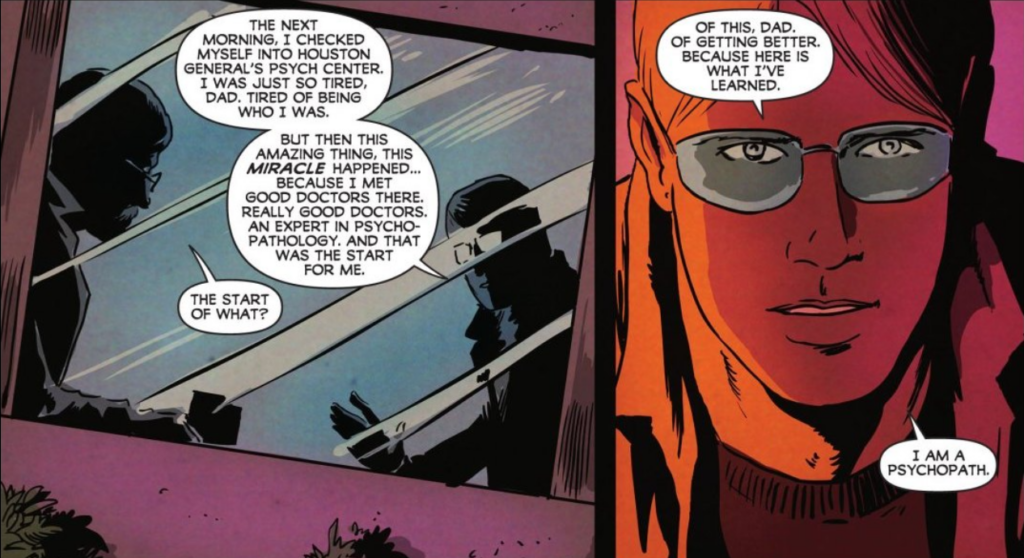
And that tells us something else, too: that joke was not an accident. It was not spontaneous. He set up for it in advance, no doubt right down to the ketchup on his shirt. Like upon manipulation upon lie upon manipulation… all disguised as an awkward joke. But in the end, even the pretense at joking is a machination… because of course James knows that his father will, inevitably, step into that bathroom.
Meanwhile, poachers have taken up “residence” in the Gotham harbor, leading Dick and Tim “Red Robin for now” Drake to investigate… in Dick’s case against all advice and despite still struggling with the effects of the toxin he encountered at the Mirror House. It makes him no less dangerous, no less skilled, but Dick can feel the cold grip of panic in the back of his mind, just as he can hear the calls of the darkness, waiting to consume him alive. He survives to investigate the poacher’s abandoned boat which, as it turns out, is absolutely loaded down with incredibly rare animals.
Dick, staring into the many eyes of a gold-backed tarantula, realizes that this is something – someone – new: a metaphorical spider, seated comfortably in the center of their web, waiting for their prey to draw near.
Now, this is much longer than I intended, so we’re going to cut it here and finish Black Mirror next time around. I’m going to try to get it done early, but the world is crazy so no guarantees. Regardless of when, however…

Next time on the Longbox View… Black Mirror Part 2, in which Dick Grayson takes on the monster with Jim Gordon’s name.
ARIEL BEE IS… An Old Person. A Comics reading veteran. Mostly involved with DC and indies but happy to go on the occasional Marvelous Mission into the unknown. An analytical overthinker. Also found as a reviewer on Comics-Watch and Twitter @thearielbee.




